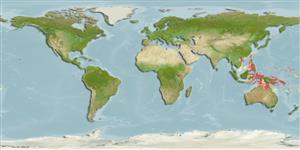Classification / Names
Common names | Synonyms | Catalog of Fishes (gen., sp.) | ITIS | CoL | WoRMS | Cloffa
Actinopterygii (ray-finned fishes) >
Perciformes (Perch-likes) >
Gobiidae (Gobies) > Gobiinae
Etymology: Tryssogobius: Greek, tryo, tryso = to wear away + see under Gobius; sarah: Named for Sarah Crow; noun in apposition.
Environment / Climate / Range
Ecology
Marine; reef-associated; depth range 50 - 75 m (Ref. 90102). Subtropical, preferred ?
Distribution
Countries | FAO areas | Ecosystems | Occurrences | Point map | Introductions | Faunafri
Western Pacific: Indonesia, Papua New Guinea, Palau and Ryukyu Islands.
Size / Weight / Age
Maturity: Lm ? range ? - ? cm
Max length : 2.2 cm SL (female)
Short description
Morphology | Morphometrics
Dorsal
spines
(total): 6 - 7;
Dorsal
soft rays
(total): 10;
Anal
spines: 1;
Anal
soft rays: 11;
Vertebrae: 26. Characterized by pearly grey to whitish head and body; yellowish first dorsal fin except thin blue anterior margin and broad blue zone basally with yellow stripe; bluish second dorsal fin with pair of yellow strips; translucent caudal fin with blue-edged yellow band across upper and lower lobe; bluish anal fin with midlateral yellow stripe ending at acute posterior tip of fin; white pelvic fins with bluish posterior tip; dorsal rays VI+I,10; anal rays I,11; pectoral rays 17-18; cheeks with single row of scales; depth of body at level of pelvic fins 4.6-5.1 in SL; relatively narrow first dorsal fin, pointed at tip; pelvic fins reaching slightly beyond origin of anal fin, tip pointed; scales in longitudinal scale series 24-26; transverse scale rows 7-8; median predorsal scales 6, progressively larger anteriorly; body scales ctenoid to below posterior part of first dorsal fin, cycloid anteriorly; gill rakers 3-4+10-14; vertebrae 26 (Ref. 90102).
Occurs in areas exposed to relatively strong currents (Ref. 90102).
Life cycle and mating behavior
Maturity | Reproduction | Spawning | Eggs | Fecundity | Larvae
Allen, G.R. and M.V. Erdmann, 2012. Reef fishes of the East Indies. Perth, Australia: Universitiy of Hawai'i Press, Volumes I-III. Tropical Reef Research. (Ref. 90102)
IUCN Red List Status (Ref. 115185)
CITES (Ref. 94142)
Not Evaluated
Threat to humans
Harmless
Human uses
More information
CountriesFAO areasEcosystemsOccurrencesIntroductionsStocksEcologyDietFood itemsFood consumptionRation
Common namesSynonymsMetabolismPredatorsEcotoxicologyReproductionMaturitySpawningFecundityEggsEgg development
Age/SizeGrowthLength-weightLength-lengthLength-frequenciesMorphometricsMorphologyLarvaeLarval dynamicsRecruitmentAbundance
ReferencesAquacultureAquaculture profileStrainsGeneticsAllele frequenciesHeritabilityDiseasesProcessingMass conversion
Tools
Special reports
Download XML
Internet sources
